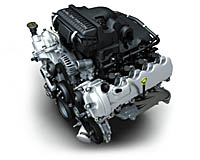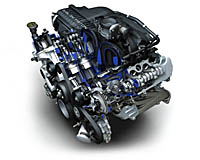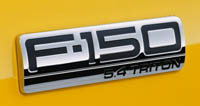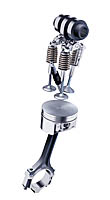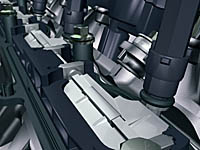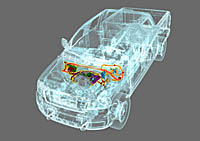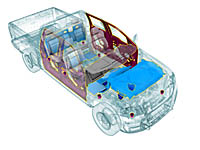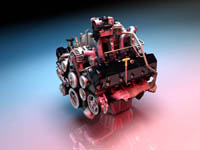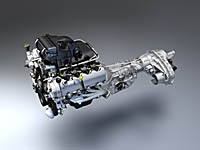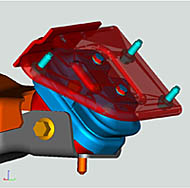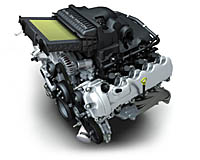2004 Ford F150 Powertrain
- 3-valve design – All-new three-valve cylinder-head architecture is designed to enhance both power and efficiency.
- 300 horsepower – Combination of engine technologies produces 300 peak horsepower – a 15-percent improvement in peak horsepower over the previous 5.4-liter engine.
- 365 ft.-lb. torque – The 5.4-liter TritonTM V-8 boasts a 7-percent improvement in low-speed torque, and 5 percent increase in peak torque, to 365 foot-pounds.
- Torque advantage – Low-end torque is higher than competitive non-heavy-duty pickup truck engines.
- Variable cam timing – Variable intake camshaft timing provides a broader torque curve, better response, improved efficiency and reduced emissions.
- Electronic throttle control – The segment’s first torque-based electronic throttle control yields a smooth, consistent response.
- Refined sound – Carefully crafted sound quality and reduced noise, vibration and harshness stem from a tuned intake resonator, a tuned low-restriction exhaust system and other improvements.
- Upgraded transmission – A new 4R75E automatic transmission handles the impressive torque output.
- Electronic throttle control – Electronic throttle control aids in response and driveability.
- Reduced emissions – Lower emissions levels, particularly hydrocarbons, are the result of new seals.
- Refinement – Powertrain engineers focused on fuel-injection refinement and reliability improvements.
- Improved transmission – Enhanced 4R70E automatic transmission provides consistent shift quality.
- A special “cold-start” strategy allows the new three-valve engine to bring the exhaust catalyst to operating temperatures more quickly, reducing emissions in the first minutes of operation.
- Variable valve timing reduces pumping losses, the work required to pull air in and push exhaust out of the cylinder.
- This design automatically channels a portion of burned gases back into the cylinder, to improve efficiency and reduce emissions. In addition to eliminating the external exhaust gas recirculation (EGR) circuit, this design reduces temperatures inside the intake manifold. Cooler combustion reduces production of the pollutant NOx.
- Engineers were able to shape a torque curve that is higher at low engine speeds, without sacrificing high-end power.
- A redesigned torque converter improves launch performance and increases efficiency.
- A turbine speed sensor improves transmission control, providing the basis for fully electronic shift scheduling to limit “hunting” and to fine-tune shift speed and feel.
- Increased microprocessor speed improves responsiveness and precision of the control system.
- “Smart” fully electronic shift scheduling knows what the torque will be in the next gear so it chooses the shift points based on the vehicle’s projected performance in the next gear.
- Coupled with the electronic throttle strategy, the transmission computes the output torque required to maintain the vehicle speed, and chooses the correct gear and converter state accordingly.
- A sealed case and lifetime transmission fluid make the transmission maintenance free, while adaptive pressure control maintains consistent shift feel over time.
2004 Ford F150 Powertrain “Our new 5.4-liter, 3-valve TritonTM engine provides more of the qualities our customers love in a V-8 engine – plenty of power, with instant gratification when you push the accelerator pedal. To this, we’ve added a new level of smoothness, quiet operation and efficiency. It’s the best of all worlds.” 5.4-liter, 3-valve TritonTM V-8 Improved 4.6-liter TritonTM V-8 REFINED POWER
The new 5.4-liter TritonTM V-8 engine that powers Ford’s next-generation F-150 is designed with three valves per cylinder, variable cam timing and a host of other features that provide increased power – especially at low engine speeds – along with improved refinement and fuel economy. The net result is an engine that delivers 300 horsepower at 5,000 rpm, and 365 foot-pounds of torque at 3,750 rpm – the new 5.4-liter, 3-valve TritonTM V-8. The all-new, aluminum cylinder head – with two intake valves and one exhaust valve per cylinder for 24 valves in total – and a new cast-iron block balance this impressive power with better fuel efficiency and quieter operation. This new technology builds on Ford’s proven modular V-8 engine platform, while taking advantage of the capabilities offered by modern electronic controls. It is important to note that it isn’t a single technology, but rather a suite of enhancements, that deliver these consumer benefits. The new 3-valve engine will be Ford’s first modular V-8 to use variable cam timing, which allows engineers to optimize intake and exhaust valve actuation across the engine speed range. It is the industry’s first mass application of dual-equal variable-cam timing, which shifts the intake and exhaust valve timing together. In combination with precise control of spark timing, fuel injection and the use of electrically controlled Charge Motion Control Valves in the intake ports, this technology produces impressive power and torque, particularly at the lower engine speeds that are so important to applications such as towing and heavy hauling. NEW 5.4-LITER, 3-VALVE ENGINE CRANKS OUT TORQUE
Low-end torque has been a hallmark of the TritonTM V-8 engine line since it was launched in 1997. The 5.4-liter, 3-valve TritonTM V-8 will have even more of a good thing. Torque is the twisting force that turns the wheels. It’s what gets a heavily loaded vehicle moving from a standing start without straining, and keeps it accelerating as engine speed increases. The new 5.4-liter, 3-valve TritonTM V-8 has even more low-end torque than before, and considerably more torque at the high-end, thanks to its free-breathing, 3-valve head design. “We make more than 80 percent of peak torque starting at 1,000 rpm,” says Pete Dowding, Modular Engines Manager. “And the torque increases at a relatively steady rate throughout the rev band.” THREE-VALVE CYLINDER HEAD IMPROVES MAXIMUM POWER The modular V-8 engine family is one of the most important product ranges in Ford’s powertrain lineup. The company built 1.3 million of these engines in the 2001 calendar year. While the two-valve modular V-8 line continues to deliver solid, efficient performance, Ford Motor Company’s premium V-8 engines – such as the Mustang Mach I and SVT Cobra, Mercury Marauder and Lincoln Aviator powerplants – have shown the performance potential of multi-valve arrangements. The use of two intake valves enhances fuel-air mixing prior to combustion. This helps to squeeze all the energy out of each combustion event, improving power delivery and fuel efficiency.
Multiple valves also enhance the engine’s ability to “breathe” – that is, to move large volumes of air in and out of the cylinders – which is a key element of generating power. Four-valve engines remain Ford Motor Company’s first choice for high-performance applications, where horsepower and acceleration are prime concerns, but they require considerable complexity, including two camshafts per cylinder head, which adds weight, cost and additional moving parts. Ford engineers discovered they were able to get many of the benefits of a four-valve design – such as a central spark plug and symmetrical combustion chamber – using two intake valves and a single exhaust valve – with reduced weight and complexity compared with four-valve designs. The two intake valves allow peak airflow of approximately 350 cubic feet per minute, compared with about 250 cubic feet per minute in the 5.4-liter TritonTM V-8, which uses a single intake valve per cylinder. This is a 40-percent improvement. As an example of the engine team’s holistic approach, this improvement in peak flow also is due to a completely redesigned intake port, which provides a much straighter path to the cylinder – very similar to the approach taken in racing engines. With all-aluminum heads, single overhead camshafts, magnesium camshaft covers and a clean-sheet design approach, Ford’s engineers were able to develop a three-valve-per-cylinder engine that has virtually no weight penalty over the two-valve V-8 engines. The three-valve head is actually dimensionally smaller than the two-valve design for the 5.4-liter engine, while offering more rigidity and strength. It also is easier to manufacture, with simpler drilling angles and straight-machined surfaces. VARIABLE CAMSHAFT TIMING (VCT) OFFERS MULTIPLE BENEFITS
Ford’s new three-valve cylinder head uses a single overhead camshaft for each bank of cylinders. The cam lobes press down on rocker arms to open the intake and exhaust valves, which are closed by coil springs, as in all Ford’s V-8 engines. Conventional camshafts are permanently synchronized with the engine’s crankshaft so that they operate the valves at a specific point in each combustion cycle. In Ford’s modular two-valve 5.4-liter V-8 engine, the intake valve opens slightly before the piston reaches the top of the cylinder and closes about 60 degrees after the piston reaches the bottom of the stroke on every cycle. Variable camshaft timing allows the valves to be operated at different points in the combustion cycle, to provide performance that is precisely tailored to the engine’s specific speed and load at that instant. The Powertrain Control Module (PCM) directs solenoids to alter the oil flow in the hydraulic cam timing mechanism, which rotates the camshafts in relation to their drive sprockets. The unit can shift between fully advanced and fully retarded in milliseconds. The result is enhanced efficiency under low-load conditions, such as at idle or highway cruising, and increased power for brisk acceleration or times of high demand. “When you’re driving, you can’t tell that the cams are changing,” says Dowding. “But you can certainly tell that there’s more power when you ask for it.” The ability to control valve timing, as well as spark timing, allowed Ford engineers to design a combustion chamber with a higher compression level than in the two-valve V-8 engines – while still using regular gasoline octane levels. A higher compression ratio produces greater efficiency, delivering more power and improved combustion efficiency. Among the other advantages generated by variable camshaft timing and electronic spark control:
CHARGE MOTION CONTROL VALVES AID COMBUSTION The air-fuel mixture entering an engine behaves differently at different engine speeds and loads. At low engine speeds and light loads, relatively little air is drawn into the cylinders in a given time period, so it moves relatively slowly through the intake runners and into the cylinders. At high engine speeds, the intake mixture speeds up, as a larger volume passes through the intake runners over the same time period. At lower speeds and lighter loads, the new three-valve engine uses an electronically controlled metal flap at the end of each intake runner – eight in all. These Charge Motion Control Valves are specially shaped to speed up the intake charge and induce a tumble effect in the combustion cylinder. This causes the fuel to mix more thoroughly, and to burn quickly and efficiently. The CMCVs are controlled by an electronic motor and open at a predetermined point as engine speed increases. At higher engine speeds, they do not affect the intake charge at all. This allows undisturbed maximum flow into the combustion chambers at wide-open throttle. The CMCV control motor is sound-insulated, so its operation remains transparent to vehicle occupants. REFINEMENT AND RESPONSE OF ELECTRONIC THROTTLE CONTROL
New on both the 5.4-liter and 4.6-liter engines is a segment-first electronic throttle control that uses the input from the accelerator pedal to actively modulate the torque at the drive wheels. It is a direct descendant of technology first used in fighter aircraft. Replacing the mechanical throttle linkage is an accelerator position sensor in the cabin, an electronic control circuit and an actuator at the throttle valve on the engine. A software algorithm takes into account the current operating status of the engine and ambient conditions, then operates the throttle as needed to best deliver the output requested by the driver. This has a number of key advantages over conventional throttle linkages, including seamless and consistent engine response, improved fuel economy and enhanced integration of vehicle systems, such as the transmission, variable camshaft timing, vehicle speed control and idle speed control. A primary advantage over mechanical systems is the ability to tune the throttle response in relation to vehicle speed. When starting from a stop, for example, the “tip-in” of the accelerator is progressive and predictable, so that the driver can pull away smoothly. While under way, the truck responds instantly and strongly to more pressure on the pedal. Additionally, the throttle-control curves are tuned to remain consistent over a wide range of operating conditions, including temperature and altitude, which influence engine response and power. Although the density of the air still limits peak engine power because there is less oxygen available for combustion, part-throttle response does not degrade with high altitude or high temperatures. Similarly, the shift schedule is electronically managed for a consistent feel under all driving conditions. For off-road travel, Ford engineers used the flexibility of ETC to give four-wheel-drive F-150s a special throttle calibration while in low range. Only available on the all-new F-150, the new Range Rover and a $50,000 off-road specialty vehicle, this feature is designed to help rock-crawlers modulate engine power better in certain situations. Because the stiff metal cable between a traditional accelerator pedal and the engine is eliminated, so is a traditional pathway into the cabin for noise and vibration. Pedal feel is not as subject to degradation over time due to friction and wear. ETC SAFETY FEATURES The ETC system has numerous safety features, including redundant sensors and double return springs at the accelerator pedal, dual sensors at the throttle valve, a closed-throttle-default actuator, redundant microprocessors and self-diagnostic software. Multiple fail-safe mechanisms are provided by the software and hardware, and the system is fault-tolerant: if only a minor fault is detected, “limp-home” modes allow the truck to move under its own power. In the remote chance of failure, the powertrain control module is designed to shut off the fuel injectors, preventing engine runaway. ATTENTION TO DETAIL Like the improvements in overall engine performance, improvements in the new three-valve engine’s refinement result from a host of design features, rather than a single breakthrough. In an example that is typical of the holistic approach Ford engineers brought to this new engine design, the same intake and exhaust manifolds that produce better air flow and improved efficiency also have been designed to offer quieter operation.
Ford’s noise, vibration and harshness (NVH) engineers used computer modeling to design vibration-resistant ribbing and reinforcement into the composite intake manifold. Because the intake area is so important to customers’ perceived sound levels – it is the closest engine component to the driver’s ears – sound is further managed through use of sound-insulating materials and a three-part tuned mass absorber in the “valley” beneath the intake runners, and with a new sound-absorbing engine cover that wraps around the edges of sound absorbing blankets at the front and rear of the engine. The intake manifold alone represents a host of refinements to previous models. For the first time, the manifold arrives at the assembly plant with the fuel rail, air cleaner, throttle body and PCV unit in place. This makes assembly much faster and reduces complexity. The main portion of the manifold is friction-welded together for durability. Even the air filter assembly is innovative, with a slide-out drawer offering customers quick access to the cleaner element for service. The new engine’s pistons have been shaped with noise reduction in mind. The pistons have longer side skirts than in the past, which helps to control piston movement and minimize piston slap. The three-valve design itself helped to reduce operating noise, as the engineers were able to balance the forces generated by valve and spring movement against each other, and aim the resultant force vectors toward the engine’s overall center of gravity. This reduces total engine vibration – which equates to reduced noise. The smaller cylinder heads naturally have a smaller surface area, which helps to reduce radiated noise. Roller-finger camshaft followers used in the cylinder head are both more efficient and quieter than non-roller designs. Also at the top of the engine, new magnesium cam covers offer the vibration-resistance of aluminum, at reduced weight. They are further isolated from vibration via rubber mounts. Reinforcing ribs cast into the cam covers, as well as a reinforcing plate in the underside of the covers, were both computer designed to minimize audible vibrations.
NVH engineers took a different approach with the engine’s front cover, which must bear the mechanical stresses of the accessory drive belt. In the new “controlled standoff” design, solid metal is used at the points where the cover bolts to the engine block, but a rubber gasket damps vibrations between mounting points. This refinement alone is responsible for a one-decibel reduction in overall sound levels. Behind this cover, the camshaft drive chains are now controlled by a new tensioner, which is reshaped to control small side-to-side chain movements, and the sounds associated with them. The engine block itself is stiffer than in the past, through addition of computer-designed reinforcements cast into the block sidewalls, and thicker metal along the gasket surfaces. This, in combination with a new style oil pan made of a sandwich of metal around a plastic core, helps to minimize sound transmission through the bottom of the engine. These designs were all validated through extensive measurement in Ford’s Advanced Engineering Center dynamometer cells – acoustic rooms where developmental engines are run while surrounded by sensitive microphones. Ford has eight such dyno cells in its Advanced Engineering Center. CONFIDENT SOUND QUALITY While precise control of overall noise is key to delivering a refined powerplant, silence isn’t everything. Ford’s approach to powertrain development includes engineering the right kinds of sounds into each vehicle. For example, Ford vehicles must provide appropriate audible feedback, as well as brisk acceleration, when the driver steps hard on the gas pedal.
This sound of power – only present during brisk acceleration – is created by tailoring the engine’s NVH package to allow the right amount of fourth-order resonance to reach the passenger compartment. This tonal quality represents the sound of V-8 engine performance, and is tuned through precise shaping of the intake and exhaust systems, as a part of the entire NVH program. This isn’t a one-size-fits-all approach, however. While the Ford F-150 has a distinctive “tough truck” sound under full throttle, it is different than the throaty sound of the Mustang, for example. The Ford Thunderbird has its own powertrain character, which is distinct from that of the Ford Outfitters sport utility lineup. Each vehicle development team crafts its entire powertrain package to achieve the brand’s desired characteristics. On the new three-valve engine, the equal-length intake runners are optimized for both power delivery and sound quality. For example, the variable Charge Motion Control Valves at the end of each intake runner close down to create turbulent airflow at low engine speeds, for efficient burning. At higher engine speeds, they open completely, to allow full airflow and quiet operation. The exhaust manifolds represent a complete departure from the flat, pancake-style cast iron manifolds of the past. The exhaust runners are twice as tall – 60 millimeters versus 30 millimeters – which helps to improve flow, and are more circular in cross-section, which improves NVH. The runners also are more widely separated than in past designs. They are braced together with computer-designed webbing, which is curved for NVH efficiency.
The new exhaust manifold design is able to forgo the exhaust gas recirculation port, due to the cylinder head’s unique design. This reduces turbulence, and balances pressures among the exhaust runners. ENGINE PRODUCTION The new three-valve cylinder head will be manufactured at the Windsor (Ontario) Engine Plant with the full engine assembled at the Essex (Ontario) Engine Plant, also in Windsor. The two plants – both past winners of the prestigious Shingo Award for Excellence in Manufacturing – combined to produce 1.1 million V-6, V-8 and V-10 engines in 2001. IMPROVEMENTS TO 4.6-LITER V-8 The 4.6-liter TritonTM V-8 achieves 231 horsepower at 4,750 rpm and an impressive 293 foot-pounds of torque at 3,500 rpm. Ninety percent of this torque is available at 2,000 rpm for strong towing performance and solid acceleration while hauling heavy loads.
It features a deep-skirted cast-iron cylinder block, cross-bolted main bearing caps tied directly to the skirt, deep-mounted cylinder head bolts and three-layer steel head gaskets. The single-overhead-camshaft (SOHC) valvetrain has roller-finger followers for quietness and is maintenance-free. In addition to the benefits of the new electronic throttle control system, the 4.6-liter modular V-8 has reduced hydrocarbon emissions for 2004 thanks to improved gaskets, seals and crankcase-ventilation plumbing. The new electronic fuel injection system is a returnless design, so it has fewer components, generates less gasoline vapor, and slightly improves fuel efficiency. Injectors with reduced mechanical noise and a stainless-steel damper-less fuel rail produce less noise, while streamlined component design improves engine appearance. ENHANCED AUTOMATIC TRANSMISSIONS Matched to the new 5.4-liter V-8 is a new 4R75E automatic transmission, an evolution of the 4R70E used on the current F-150. Upgraded to handle the torque of the 5.4-liter engine, this transmission shares patented upgrades with the 4R70E, which backs the 4.6-liter V-8: By predicting the performance of the truck in the next gear, the computer-controlled transmissions provide a more sophisticated solution to heavy demands than a simple shift delay switch, such as the one-size-fits-all “towing mode” some competitors use. FOUR-WHEEL-DRIVE SYSTEMS F-150 is offered in both 4×2 and 4×4 drive configurations. The 4×4 models have two-speed transfer cases with optional electric shift-on-the-fly capability, controlled from a dash-mounted rotary knob. Whether manually or electronically shifted, F-150’s proven part-time four-wheel-drive system provides the traction truck users need for heavy hauling and off-road crawling. In low range, the electronic throttle control changes to a special off-road calibration for more precise torque management in the worst conditions, such as a sandy hill climb or when pulling a heavy boat out of the water on a moss-slicked ramp. For even more traction, a limited-slip rear differential is available on all F-150 models. FUEL ECONOMY AND ENVIRONMENTAL PROTECTION While final certification is not yet complete, Ford expects the new F-150 to offer competitive fuel economy. The new three-valve 5.4-liter V-8 in the 2004 F-150 meets the U.S. federal government’s Tier 2, Bin 8 Emission Vehicle standard. The 4.6-liter V-8 meets Tier 2, Bin 10 Emission Vehicle standard. Beginning in 1998, Ford pledged to engineer all of its sport utility vehicles and Windstar minivans with Low-Emission Vehicle (LEV) certification, five years before regulatory requirements. In 1999, Ford announced that it would do the same with its popular F-Series pickup trucks. SERVICEABILITY
Owning an F-150 – or any Ford product – should be hassle-free, even when it comes to maintenance. All 2004 F-150s have a new lifetime automatic transmission fluid that never needs changing. On the 5.4-liter engine, the air filter slides out in a special drawer for easy changing. Both the 4.6-liter and 5.4-liter engines can go 100,000 miles before their first scheduled tune-up, under normal driving conditions and with regular fluid and filter changes. |

